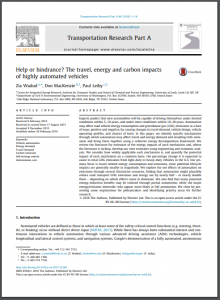Full Title: Help or hindrance? The travel, energy, and carbon impacts of highly automated vehicles
Author(s): Zia Wadud, Don MacKenzie, and Paul Leiby
Publisher(s): Transportation Research Part A: Policy and Practice
Publication Date: February 1, 2016
Full Text: Download Resource
Description (excerpt):
Experts predict that new automobiles will be capable of driving themselves under limited conditions within 5–10 years, and under most conditions within 10–20 years. Automation may affect road vehicle energy consumption and greenhouse gas (GHG) emissions in a host of ways, positive and negative, by causing changes in travel demand, vehicle design, vehicle operating profiles, and choices of fuels. In this paper, we identify specific mechanisms through which automation may affect travel and energy demand and resulting GHG emissions and bring them together using a coherent energy decomposition framework. We review the literature for estimates of the energy impacts of each mechanism and, where the literature is lacking, develop our own estimates using engineering and economic analysis. We consider how widely applicable each mechanism is, and quantify the potential impact of each mechanism on a common basis: the percentage change it is expected to cause in total GHG emissions from light-duty or heavy-duty vehicles in the U.S. Our primary focus is travel related energy consumption and emissions, since potential lifecycle impacts are generally smaller in magnitude. We explore the net effects of automation on emissions through several illustrative scenarios, finding that automation might plausibly reduce road transport GHG emissions and energy use by nearly half – or nearly double them – depending on which effects come to dominate. We also find that many potential energy-reduction benefits may be realized through partial automation, while the major energy/emission downside risks appear more likely at full automation. We close by presenting some implications for policymakers and identifying priority areas for further research.
